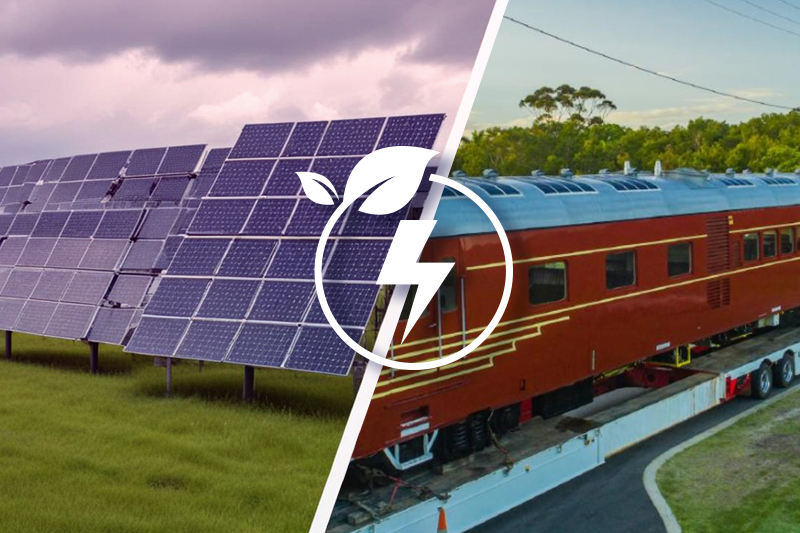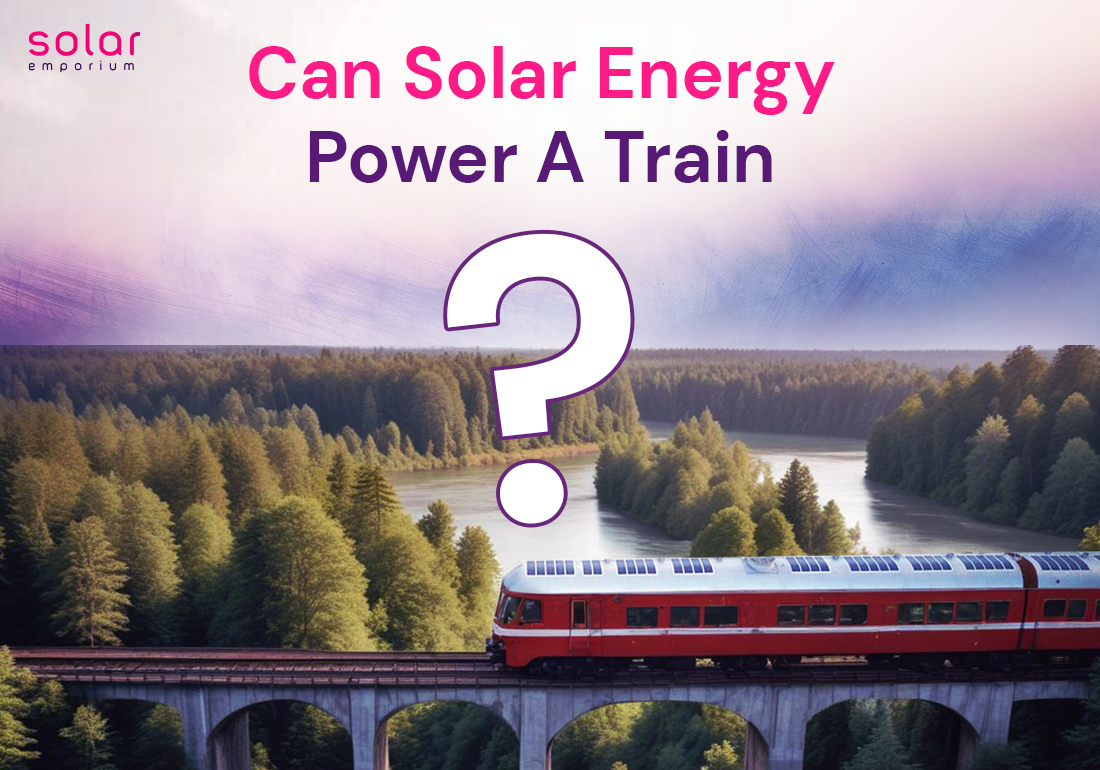Australia’s abundant renewable energy resources and cutting-edge technologies present a golden opportunity for state and federal governments to collaborate and develop a wide range of carbon-free transport options.
But the big question is, can solar energy power a train? Are solar trains possible? Solar-powering trains, in particular, offer a promising solution.
Trains have ample roof space for solar panels and run on fixed routes, making them ideal for solar energy. Additionally, trains can be conveniently recharged with solar power at each station.
Electricity is a significant contributor to greenhouse gas emissions in Australia, with transport following closely behind.
However, there’s a bright side: since 1990, the growth in transport emissions by 62.9% highlights the potential for impactful change.
Australia can significantly reduce its greenhouse gas pollution by implementing forward-thinking government policies on transport and climate.
With a growing population, improving public transport and reducing car dependence are key strategies. It is an exciting opportunity for Australia to embrace renewable-powered transport solutions, such as solar-powered cars, trams, trains, and buses, which are gaining popularity.
So, Solar Trains: What Are They, and How Do They Work?
How Do Solar Trains Work?
Solar trains are electric trains that use solar energy as their power source. They get this energy from photovoltaic cells, also known as solar panels, installed on the train’s roof or placed alongside the railway tracks.
These cells capture sunlight and convert it into electricity, which powers the train’s movement.
Usually, a solar train uses solar panels on its roof or next to the tracks. Very few solar train projects exist worldwide because it is technically challenging to power such a large vehicle with solar energy.
How the Grid Operates in Australia
The Australian electrical grid operates through interconnected transmission and distribution networks. Until now, it has been mostly centralised, which has made it easier to coordinate the integration of distributed energy resources (DERs) like solar and wind.
As the energy landscape changes, integrating DERs brings new challenges and opportunities that require innovative solutions and collaboration among various stakeholders.
This shift means we must rethink how we manage the grid to ensure it stays stable, reliable, and efficient, even as more energy is generated and decentralised.
Are There Any Solar Trains in Operation?

In 2012, as part of China’s 12th Five-Year Plan, the Shenzhen region planned to power several public facilities, including railway stations, with solar panels.
In 2010, industry publications praised the connection of 20,000 solar panels, generating 6.68 MW, to the new Hongqiao station on the high-speed line between Beijing and Shanghai.
Following this, there was interest in using these railway stations’ solar power to power trains directly. However, this transition is expected to take several decades.
However, the world’s first fully solar-powered train is a tourist train in New South Wales, Australia! Over 70 years old. Refurbished in 2017 by North Byron Resort, the train has solar panels on its roof that provide 6.6 kW of power.
This is enough to power the train for its 3 km journey between North Beach and Byron Beach stations at an 18 km/h leisurely speed.
That same year, India unveiled an ambitious national plan to reduce its reliance on a highly polluting electricity mix.
A large portion of the country’s electric fleet, supported by the Ministry of Science and Technology, incorporates solar panels on the roof of the trains, sufficient to supply approximately 15% of the energy required during the journey.
World’s First Solar Train by the Byron Bay Railroad Company
The Byron Bay Railroad Company made solar-powered transportation a reality with the world’s first solar train, which opened to the public in December 2017. A Local businessman privately funded this AUD 4 million project.
The train runs solely on solar energy, using the roof’s flexible, curved solar panels. It travels a 3 km coastal route connecting Byron Town Centre, North Beach, and Byron Arts Estate in New South Wales, Australia. And it is considered net carbon positive.
Byron Bay restored a heritage 1949 two-carriage red rattler train. The train can seat 100 people, has standing space, and has a luggage room. Its body is lightweight aluminium, and the solar panels on top generate 6.5 kW of power.
Originally, the train had two diesel engines. One of these was converted into an electric motor. The train has a battery capacity of 77 kWh, similar to a high-end Tesla Model 3.

How about the Electric Engine of the Train in Australia?
As a precaution, one diesel engine is kept in case of any issues. During winter and cloudy days, the train gets power from a certified green supplier. It runs on batteries that get 23% of its energy from solar panels on the train and its shed.
The Byron Bay Railroad Company won the 2018 Rail Sustainability Award from the Australasian Railway Association for creating the world’s first solar-powered train.
A 30kW solar panel system at the main station charges the train’s battery, allowing it to run on solar power. When fully charged, the train can make 12–15 trips. The train’s regenerative braking system also recycles much energy into the battery.
The main power can provide extra energy when needed. 77% of the solar energy the train service generates is given back to the local community.
Electric Trains in Other Countries
In the Netherlands, the Dutch National Railway uses electricity from wind turbines, including those offshore, to power their trains.
In India, railways use solar panels to power air conditioning, lights, and fans on trains, saving nine tonnes of CO2 per year per train.
Although the trains run on diesel, the solar panels help reduce utility costs. India aims to make its railways carbon-neutral by 2030 by building 20GW solar farms near railway lines to supply energy to railway substations and the grid.
Argentina plans to power a 300 km train line with rooftop solar panels and solar farms. In 2019, the UK launched the world’s first railway line powered by a 30kW solar farm. A study suggests solar energy could power 10% of the country’s train routes.
However, Byron Bay’s solar train demonstrates the potential of renewable energy in transportation. And it remains the flag bearer of renewable transportation worldwide, especially in Australia.
While many electric trains worldwide use overhead wires or electrified rails, Byron Bay’s solar train is unique because it runs on batteries charged entirely by solar energy.
So, Can Trains Be Powered Solely with Solar Energy?
Trains are very large vehicles, which means they need a lot of energy to start moving. Although it takes less energy to keep them moving (except on steep hills), it’s still a lot.
A high-speed passenger train uses about 0.03 kWh per passenger per kilometre. For a train carrying 600 passengers, that’s 18 kWh per kilometre. At a 250 km/h speed, it travels one kilometre every 14.4 seconds, using around 3.6 MW.
You would need 18,000 square meters of panels along the railway to generate this much power with solar panels.
With proper infrastructure, it is possible, and soon, it will be a regular occurrence in Australia. However, building and maintaining such infrastructure is equally important.
Solar-powered Trains are Growing in Popularity
Solar-powered trains are becoming more popular as a sustainable transportation option. These trains use solar panels on their roofs or along the tracks to generate the electricity required for operation.
Advances in solar technology and increasing concerns about climate change are driving this trend.
Countries like the Netherlands, India, Argentina, and the United Kingdom are exploring or already implementing solar-powered trains.
In the Netherlands, trains are powered by electricity from wind turbines, while India uses solar panels to power auxiliary functions like air conditioning and lighting on diesel trains, with plans to expand solar use further.
Argentina wants to power a 300 km train line with rooftop solar panels and solar farms. The UK has even launched a railway line powered by a solar farm.
These projects highlight the potential for solar energy to transform the transportation sector, offering a cleaner and more sustainable alternative to traditional fuels.
The success of solar-powered trains could pave the way for similar innovations in other forms of transport, contributing significantly to reducing greenhouse gas emissions and combating climate change.
Australia’s Byron Bay Solar Train is Paving the Future of Transport!
Components

Abandoned railway lines and old trains are being brought back to life for passengers’ enjoyment. The Byron Bay Railroad Company train, with its beautiful brick-red cars and vintage leather seats, is part of this trend.
A 6 km round trip on this train uses 5 kWh of solar energy. Any extra electricity is sent back to the local grid.
This unique train doesn’t run on steam or diesel but solar energy. It offers a nostalgic journey through the past while showcasing the future of renewable energy.
The non-profit Byron Bay Railroad Company replaced one of the train’s diesel engines with a lithium-ion battery, keeping the other diesel engine as a backup.
They installed two sets of solar panels to power the battery: one on the train’s roof and another at the North Beach station. The solar panels charge the battery during the journey and when the train is at the station.
Additionally, they installed a regenerative braking system, which turns the traction motors into generators during braking, adding more power to the battery.
Don’t forget to contact Solar Emporium if you want to revolutionise your home too with solar energy! Get a free solar quote right now!







